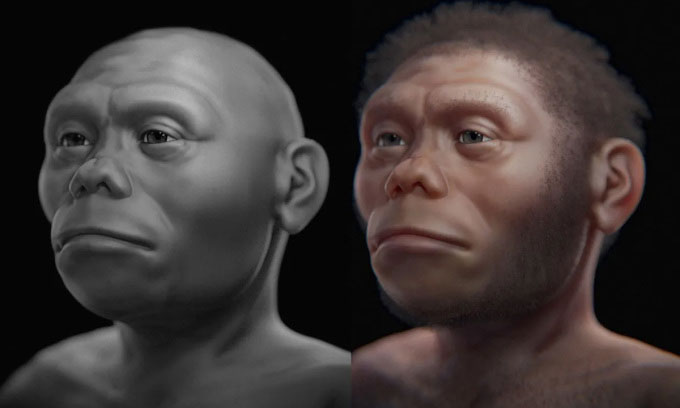Reconstructing the face of a person who lived 50,000 years ago
A team of archaeologists and 3D designers reconstructed the face of an individual belonging to the now extinct species Homo floresiensis, genus Homo (Human genus).
Nicknamed "The Hobbit" because of its short stature, Homo floresiensis was an ancient human species that stood about 1.1m tall. They appeared on Earth at the same time as modern humans, Homo sapiens , and are thought to have gone extinct about 50,000 years ago.

Reconstruction of the face of Homo floresiensis. (Photo: Cicero Moraes)
The bones of Homo floresiensis were first discovered in 2003, on the island of Flores, Indonesia. Since then, scientists have discovered more than a dozen other specimens on the island, but much remains unknown about this mysterious species.
In a new study, Brazilian 3D designer Cicero Moraes and Italian archaeologists Luca Bezzi and Alessandro Bezzi studied the skull of Homo floresiensis to reconstruct its face, IFL Science reported on June 29. They used the shape and structure of the skull to estimate how soft tissue adhered to bone. The study was based on scans of LB1, a nearly complete skeleton of Homo floresiensis from Liang Bua Cave on Flores Island.
Reconstructing a face based on a skull alone is not an exact science and requires a bit of an art. This is because skull shape can provide only limited information about how soft tissues, such as muscle and fat, are actually distributed in the face. Furthermore, it is not known for sure what color or how much hair Homo floresiensis had, so some features must be based on educated guesses.
Moraes describes some differences between Homo floresiensis and modern humans. "It's possible that their noses were not as high as modern humans, their mouths were slightly more protruding than ours, and their brain volume was significantly smaller ," he says.
To reconstruct the face of an extinct species, the team used CT scans from both humans and chimpanzees. "We edited both to match the skull structure of Homo floresiensis and added data to show what this person's face looked like ," Moraes said.
This is the first time the face of the 'Hobbit' has been reconstructed using data from both humans and chimpanzees. The new research was published in the e-book OrtogOnline in early June.
- Dress up the face of Peruvian nobles who lived 1,200 years ago
- Recreate the face of an Egyptian woman who lived 1500 years ago
- Revealing the face of a Neanderthal woman 75,000 years ago
- Surprised by the restored face of the 8,000-year-old man
- French doctors have made history, when transplanted a second face for the same person
- Looking at the face guessing the personality of the person
- Detects animals they are 12 million years old with many modern facial features
- Successfully reconstructed the face of the victim of a 1400-year-old barbaric murder
- Who lived 13,600 years ago, the oldest in America looked like this?
- The face of the real person lived thousands of years ago, 'beautiful every millimeter' caused many people to be deceived
- His face cried on the ice
- The process of human face evolved 6 million years in just 1 minute
 Discovered an ancient centipede fossil 99 million years old
Discovered an ancient centipede fossil 99 million years old Discovered bat-like dinosaurs in China
Discovered bat-like dinosaurs in China Discovered a 200-year-old bronze cannon of the coast
Discovered a 200-year-old bronze cannon of the coast Discover 305 million-year-old spider fossils
Discover 305 million-year-old spider fossils